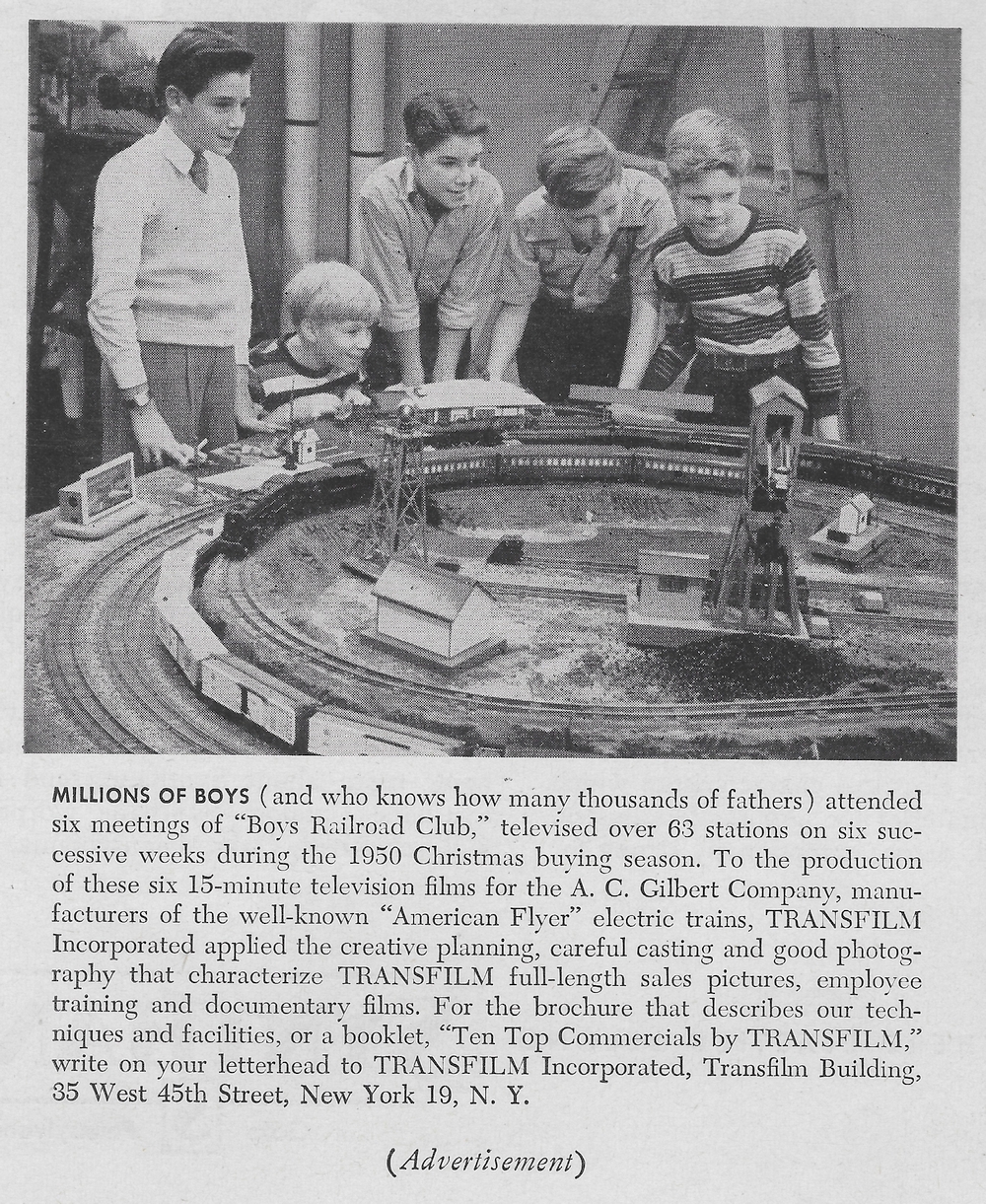Boys' Railroad Club
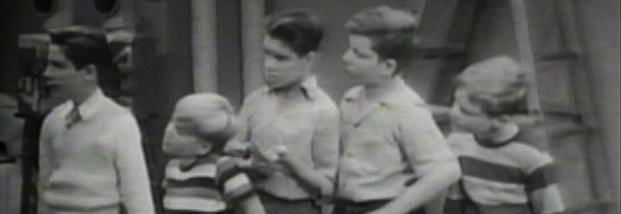
Click on the image below to see
photos of the studio layout
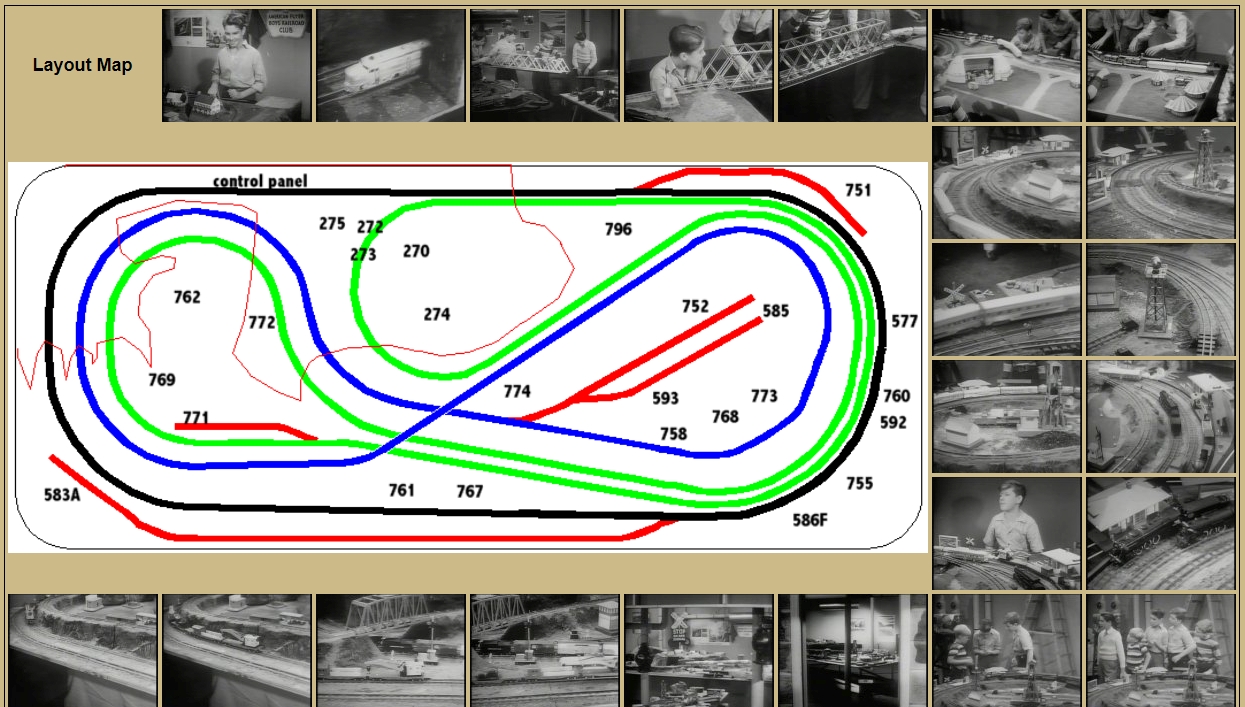 The
Boys' Railroad Club was a series of short 15 minute pre filmed shows
featuring American Flyer Trains.
The show aired in October, November and December 1950.
It was repeated during that same time period for the next two years. There were 6 episodes of the TV program produced, each one
featuring an employee of a major railroad who discussed his job
interspersed with prototype railroad shots and shots of the layouts
in action. The Pennsylvania Railroad, the Baltimore and Ohio
Railroad, the New Haven Railroad, and the Union Pacific Railroad
were each featured in one episode. The New York Central Railroad was
featured in two. In the Boys' Railroad Club TV program, Gilbert sought to create
the impression that the boys were running their trains on one huge
layout. In actuality, two layouts were used. The first, and the
one on which most of the action occurs, is the 2nd Floor layout at
the New York Hall of Science. Still shots from the TV show that
illustrate this layout can be found in the section of this website
devoted to the New York Hall of Science 2nd floor layout. The second layout used, and the
one that will be explored in this section, was a smaller studio
layout used for all the shots which included the boys. This studio
layout was almost identical to the 7 x 16 foot Sibley department
store layout discussed in other sections of this website. In
addition to this layout, an add on panel was also used in several
episodes for featured shots, such as those involving the American
Flyer Circus and the placement of an aisle spanning erector bridge.
The
Boys' Railroad Club was a series of short 15 minute pre filmed shows
featuring American Flyer Trains.
The show aired in October, November and December 1950.
It was repeated during that same time period for the next two years. There were 6 episodes of the TV program produced, each one
featuring an employee of a major railroad who discussed his job
interspersed with prototype railroad shots and shots of the layouts
in action. The Pennsylvania Railroad, the Baltimore and Ohio
Railroad, the New Haven Railroad, and the Union Pacific Railroad
were each featured in one episode. The New York Central Railroad was
featured in two. In the Boys' Railroad Club TV program, Gilbert sought to create
the impression that the boys were running their trains on one huge
layout. In actuality, two layouts were used. The first, and the
one on which most of the action occurs, is the 2nd Floor layout at
the New York Hall of Science. Still shots from the TV show that
illustrate this layout can be found in the section of this website
devoted to the New York Hall of Science 2nd floor layout. The second layout used, and the
one that will be explored in this section, was a smaller studio
layout used for all the shots which included the boys. This studio
layout was almost identical to the 7 x 16 foot Sibley department
store layout discussed in other sections of this website. In
addition to this layout, an add on panel was also used in several
episodes for featured shots, such as those involving the American
Flyer Circus and the placement of an aisle spanning erector bridge.
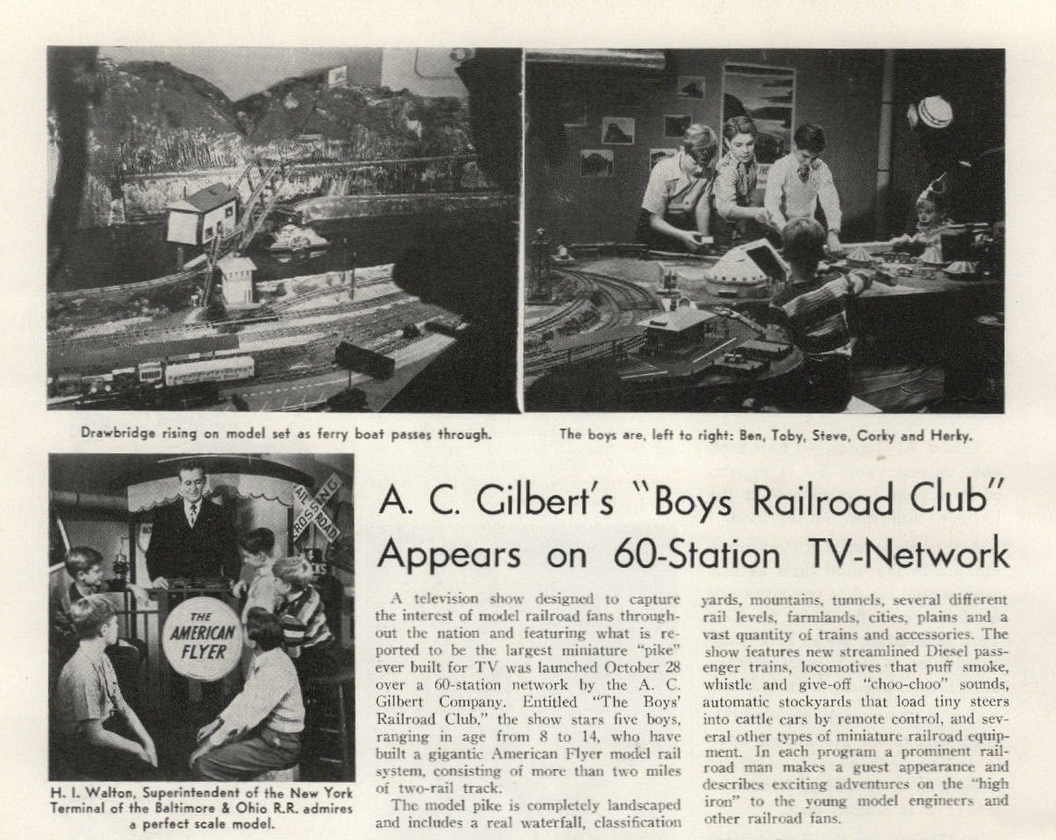
From Playthings Magazine, December 1950, Page 132 - Courtesy of
Lonny Beno
Low resolution copies of all six programs are available on the RFGCO YouTube site. They can be found at the following links. Commercial videos on both VHS tape and DVD have been sold in the past and may still be available.
|
Episode 1 New Haven R.R. |
Episode 2 New York Central R.R. |
Episode 3 New York Central R.R. |
|
Episode 4 Union Pacific R.R. |
Episode 5 Pennsylvania R.R. |
Episode 6 Baltimore & Ohio R.R. |
Where is this layout today?
Though some have suspected that the Sibley department store layout was the layout used in the television program, Clay Buckage, the present owner of that layout confirms that there are distinct differences and that his layout is not the one that was used in the show.
According to Emil Suda, the Boys' Railroad Club layout simply sat in storage in the New York Hall of Science through the years between 1950, when it was used in the television program and 1967, when the building was being cleaned out. It was then that it was originally sold.
Recently, Emil brought to my attention the American Flyer Collector's Column in an S-Gaugian Magazine from 1985 that discusses a wide variety of display layouts used in the promotion of American Flyer products. 1 One of the layouts discussed there was the Boys' Railroad Club layout. At the time of that article the actual layout used in the studio shots was found to be in the possession of collector Fred H. Whitley, Jr., who had apparently purchased it from the original purchaser in the early 1980's. As of the year of that article, 1985, Mr. Whitley was attempting to restore it. I understand that restoration is still in progress. If you can add anything to the above information, please contact me at the Contact Us link on the home page.
The Other Boys' Railroad Club
To read the Young Catholic Messenger article, just click here or on cover mage.
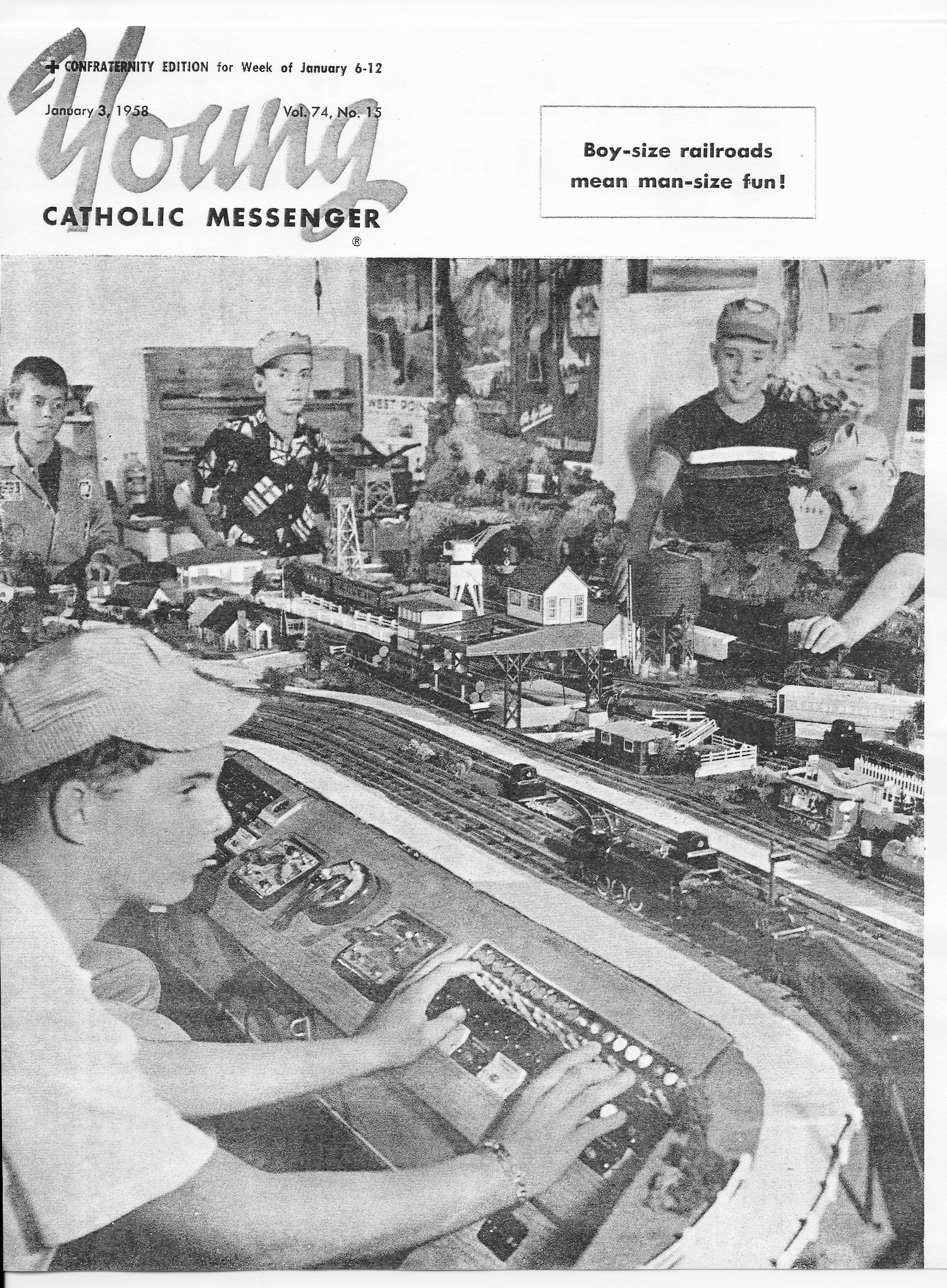 The
date of the publication at the left is January 3, 1958, but
this photo also appeared in one of the photo sections of
"The Man Who Lives in Paradise," the autobiography of A.C.
Gilbert, which was first published in 1954. Additional
photos of the same layout appeared in other publications as
early as 1952.
The photo featuring Yul Brynner, included in the Young
Catholic Messenger article, was published in December
1952 in Illinois Central Magazine, so the layout
can be no later than that date. In addition, the equipment shown in the photos
is consistent with equipment from 1952. You can read
the magazine article by clicking on the illustration of the
cover. The
date of the publication at the left is January 3, 1958, but
this photo also appeared in one of the photo sections of
"The Man Who Lives in Paradise," the autobiography of A.C.
Gilbert, which was first published in 1954. Additional
photos of the same layout appeared in other publications as
early as 1952.
The photo featuring Yul Brynner, included in the Young
Catholic Messenger article, was published in December
1952 in Illinois Central Magazine, so the layout
can be no later than that date. In addition, the equipment shown in the photos
is consistent with equipment from 1952. You can read
the magazine article by clicking on the illustration of the
cover.
One of the first questions that comes to mind is, "Who are these kids." Certainly not Toby, Ben, Steve, Corky, or Herky, the boys who appeared in the television show. Also, the layout is unlike either the layout used in the shots with the boys or the 2nd Floor Gilbert Hall of Science layout that was also used in the TV show. My thanks go to Earl Hunt, who did research and came up with additional information on this group of boys and their layout as well as the entire Boys' Railroad Club concept. In the July 1999 issue of the Train Collectors Quarterly, this club and layout are mentioned in an article about the advertising of tinplate trains in 1953. 2 The Train Collectors Quarterly article references an article in the January 1953 issue of Child Life magazine that gave full details on this club and its layout. In short, the layout was located in Locust Valley, New York, in the basement of Alex Walker. Alex and five of his friends formed a Boys' Railroad Club and were given a Gilbert charter which was presented in person by Al Gilbert Jr. What is also interesting from the Child Life article is that the magazine apparently set up a contact point within the magazine itself for boys to use to get further information on how to start such a club, a further indication that Gilbert used this promotional tool even after the run of the TV show of that name. I think this whole new cast of characters is evidence that the Boys' Railroad Club was not just a television show, but a concept that Gilbert kept running for several years after the television show stopped running after 1952. At the beginning in 1950, the television show was the tie in to the club concept. Boys were urged to form their own Boys' Railroad Clubs and obtain an official charter from the Gilbert Company. With the show off the air, this Locust Valley club appears to be the new tie in. The Locust Valley Club was also pictured in a book titled "The Model Railroad Book" by Commander Warren F. Morgan and published by Fawcett, who also published Mechanics Illustrated. Photos of the layout appear on page 4 (Getting Started), page 19 (The Hi-Rail Route) and page 133 (Wiring and Controls). None of the articles specifically address the A.C. Gilbert Boys' Railroad Clubs, but the photo on page 133 identifies the location of the layout and club to be in "New York." The majority of the photos of this layout appear in the Young Catholic Messenger article above, but there are additional shots of it in the Morgan book and the Train Collectors Quarterly article. This layout has all the earmarks of being a professionally built layout but we don't have any information as to whether or not the Gilbert display department had a hand in its construction. In addition to the use of this Locust Valley club as a focus for publicity, Gilbert sponsored other efforts, including a promotion that ran in Boy's Life in 1953. As with the Child Life, promotion, the magazine also set up a contact point for club information. More information on this promotion can be found in an article in The Collector, a publication of the former American Flyer Collectors Club. 3 The Young Catholic Messenger article is also evidence that as late as 1958 this club concept was still being promoted by Gilbert as a way to support brand loyalty. It is noteworthy that official Gilbert support was not stressed in this 1958 article. In fact this article seems to tone down the Gilbert tie in, perhaps so it wouldn't seem like a blatant advertisement. 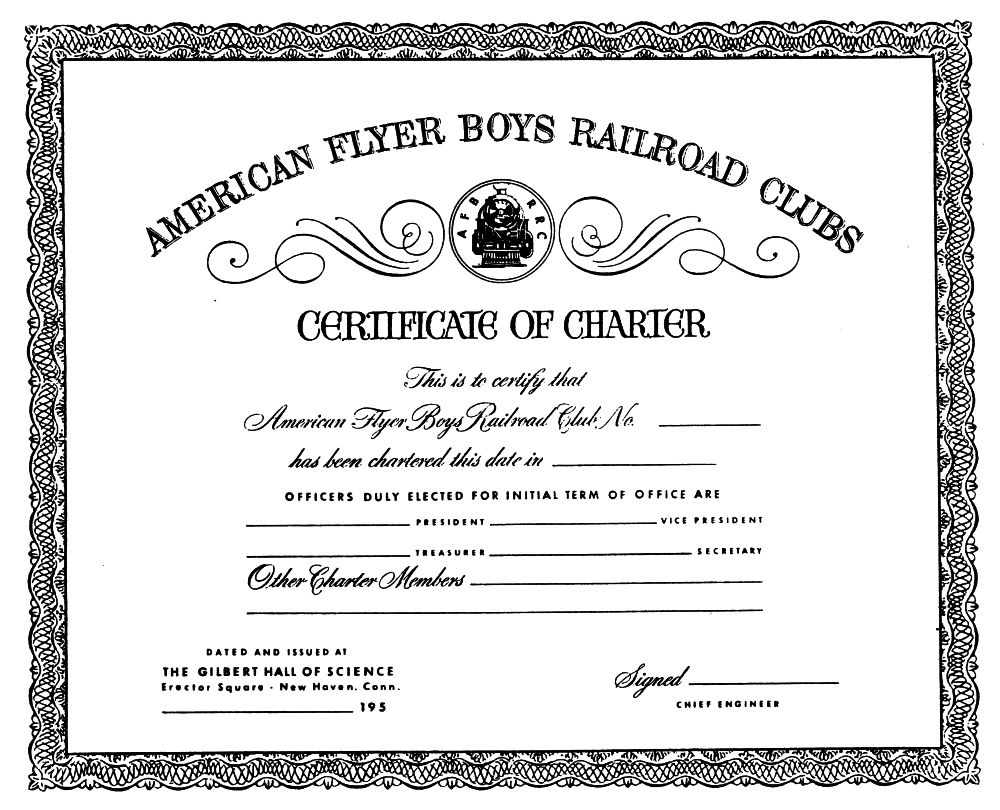 One side effect of such formally organized clubs was to
acquaint boys with the principles of corporate governance,
as witnessed by statements in the Young Catholic
Messenger article about
the clubs having a board of directors which meets to discuss
major expenditures for the club. This ties in with the
Gilbert Co. emphasis on the educational aspects of their
toys. I actually wonder how many such clubs were
formed with such a formal structure. I think it would
be more likely that the clubs operated more informally.
I was a kid in the 50's and that was not the way I viewed
the world. (scan of certificate courtesy of Earl Hunt) One side effect of such formally organized clubs was to
acquaint boys with the principles of corporate governance,
as witnessed by statements in the Young Catholic
Messenger article about
the clubs having a board of directors which meets to discuss
major expenditures for the club. This ties in with the
Gilbert Co. emphasis on the educational aspects of their
toys. I actually wonder how many such clubs were
formed with such a formal structure. I think it would
be more likely that the clubs operated more informally.
I was a kid in the 50's and that was not the way I viewed
the world. (scan of certificate courtesy of Earl Hunt) |
I am grateful to John Huster, Lonny Beno, Emil Suda and Earl Hunt for their assistance in developing this page.
1
"Gilbert Display Layouts," by Paul C. Nelson, American
Flyer Collectors Column, S Gaugian, January-February 1985, page 33
2
"Advertising Tinplate Trains, Postwar Era,
Part 8b, 1953," by Raymond J. Fetzner - Train Collector's Quarterly,
July 1999, Vol. 45, No. 3, page 20
Link to this issue
and article in the TCQ (available to TCA members only)
3 "Unusual American Flyer Paper, Pt. 2: Boy Scout
Promotions," by Robert J. Tufts - The Collector (American Flyer
Collectors Club), Fall 1990, pg. 10.
